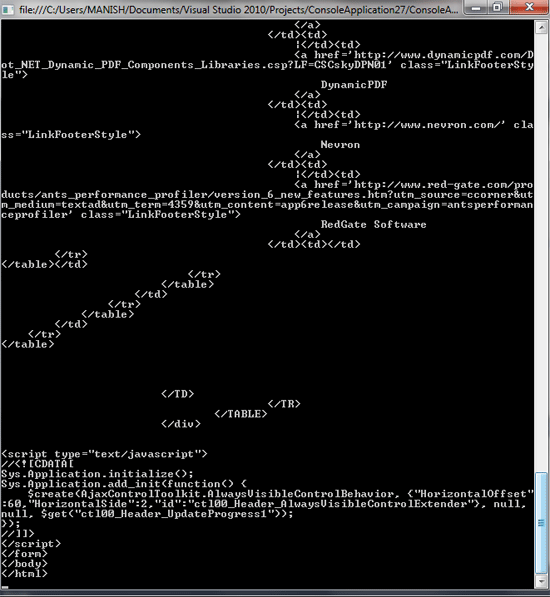String Encoding/Decoding and Conversions in VB.NET
In this article I will explain you about String Encoding/Decoding and Conversions in VB.NET.
All strings in a .NET Framework program are stored as 16-bit Unicode characters. At times you might need to convert from Unicode to some other character encoding, or from some other character encoding to Unicode. The .NET Framework provides several classes for encoding (converting Unicode characters to a block of bytes in another encoding) and decoding (converting a block of bytes in another encoding to Unicode characters.
The System.Text namespace has a number of Encoding implementations:
-
The ASCIIEncoding class encodes Unicode characters as single 7-bit ASCII characters. This class supports only character values between U+0000 and U+007F.
-
The UnicodeEncoding class encodes each Unicode character as two consecutive bytes. This supports both little-endian (code page 1200) and big-endian (code page 1201) byte orders.
-
The UTF7Encoding class encodes Unicode characters using UTF-7 encoding (UTF-7 stands for UCS Transformation Format, 8-bit form). This supports all Unicode character values and can also be accessed as code page 65000.
-
The UTF8Encoding class encodes Unicode characters using UTF-8 encoding (UTF-8 stands for UCS Transformation Format, 8-bit form). This supports all Unicode character values and can also be accessed as code page 65001.
Each of these classes has methods for both encoding (such as GetBytes) and decoding (such as GetChars) a single array all at once. In addition, each supports GetEncoder and GetDecoder, which return encoders and decoders capable of maintaining shift state so they can be used with streams and blocks.
The example given below shows various forms of the Encoding class.
Example of Encoding and Decoding
' writing
Dim fs As New FileStream("text.txt", FileMode.OpenOrCreate)
Dim t As New StreamWriter(fs, Encoding.UTF8)
t.Write("This is in UTF8")
'or
' reading
Dim fs As New FileStream("text.txt", FileMode.Open)
Dim t As New StreamReader(fs, Encoding.UTF8)
Dim s As [String] = t.ReadLine()
The next example given below makes a Web page request and then encodes the bytes returned/read as ASCII characters.
Example of String Encoding
Imports System.Net
Imports System.IO
Imports System.Text
Class MyApp
Shared Sub Main()
Try
Dim theRequest As WebRequest = WebRequest.Create("http://www.mindcracker.com")
Dim theResponse As WebResponse = theRequest.GetResponse()
Dim BytesRead As Integer = 0
Dim Buffer As [Byte]() = New [Byte](255) {}
' Buffer Size
Dim ResponseStream As Stream = theResponse.GetResponseStream()
BytesRead = ResponseStream.Read(Buffer, 0, 256)
Dim strResponse As New StringBuilder("")
While BytesRead <> 0
' Returns an encoding for the ASCII (7 bit) character set
' ASCII characters are limited to the lowest 128 Unicode
' characters
' , from U+0000 to U+007f.
strResponse.Append(Encoding.ASCII.GetString(Buffer, 0, BytesRead))
BytesRead = ResponseStream.Read(Buffer, 0, 256)
End While
Console.Write(strResponse.ToString())
Catch e As Exception
Console.Write("Exception Occured!{0}", e.ToString())
End Try
Console.ReadLine()
End Sub
End Class
Output

Conclusion
Hope this article would have helped you in understanding the String Encoding/Decoding and Conversions in VB.NET.